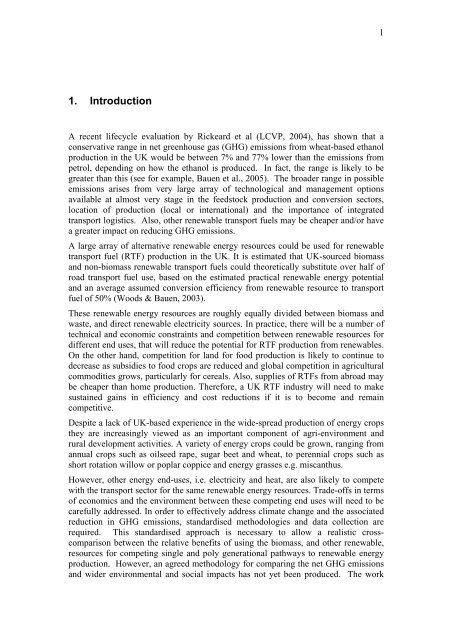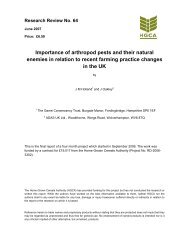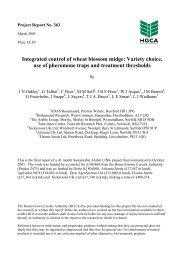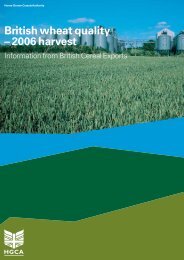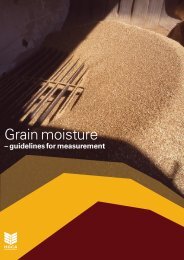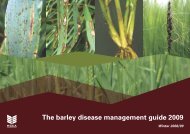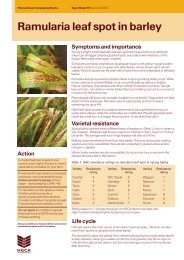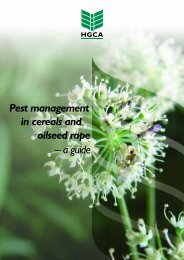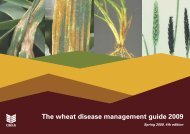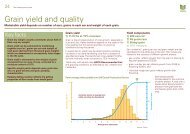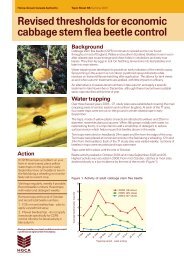BIOETHANOL GREENHOUSE GAS CALCULATOR - HGCA
BIOETHANOL GREENHOUSE GAS CALCULATOR - HGCA
BIOETHANOL GREENHOUSE GAS CALCULATOR - HGCA
You also want an ePaper? Increase the reach of your titles
YUMPU automatically turns print PDFs into web optimized ePapers that Google loves.
11. IntroductionA recent lifecycle evaluation by Rickeard et al (LCVP, 2004), has shown that aconservative range in net greenhouse gas (GHG) emissions from wheat-based ethanolproduction in the UK would be between 7% and 77% lower than the emissions frompetrol, depending on how the ethanol is produced. In fact, the range is likely to begreater than this (see for example, Bauen et al., 2005). The broader range in possibleemissions arises from very large array of technological and management optionsavailable at almost very stage in the feedstock production and conversion sectors,location of production (local or international) and the importance of integratedtransport logistics. Also, other renewable transport fuels may be cheaper and/or havea greater impact on reducing GHG emissions.A large array of alternative renewable energy resources could be used for renewabletransport fuel (RTF) production in the UK. It is estimated that UK-sourced biomassand non-biomass renewable transport fuels could theoretically substitute over half ofroad transport fuel use, based on the estimated practical renewable energy potentialand an average assumed conversion efficiency from renewable resource to transportfuel of 50% (Woods & Bauen, 2003).These renewable energy resources are roughly equally divided between biomass andwaste, and direct renewable electricity sources. In practice, there will be a number oftechnical and economic constraints and competition between renewable resources fordifferent end uses, that will reduce the potential for RTF production from renewables.On the other hand, competition for land for food production is likely to continue todecrease as subsidies to food crops are reduced and global competition in agriculturalcommodities grows, particularly for cereals. Also, supplies of RTFs from abroad maybe cheaper than home production. Therefore, a UK RTF industry will need to makesustained gains in efficiency and cost reductions if it is to become and remaincompetitive.Despite a lack of UK-based experience in the wide-spread production of energy cropsthey are increasingly viewed as an important component of agri-environment andrural development activities. A variety of energy crops could be grown, ranging fromannual crops such as oilseed rape, sugar beet and wheat, to perennial crops such asshort rotation willow or poplar coppice and energy grasses e.g. miscanthus.However, other energy end-uses, i.e. electricity and heat, are also likely to competewith the transport sector for the same renewable energy resources. Trade-offs in termsof economics and the environment between these competing end uses will need to becarefully addressed. In order to effectively address climate change and the associatedreduction in GHG emissions, standardised methodologies and data collection arerequired. This standardised approach is necessary to allow a realistic crosscomparisonbetween the relative benefits of using the biomass, and other renewable,resources for competing single and poly generational pathways to renewable energyproduction. However, an agreed methodology for comparing the net GHG emissionsand wider environmental and social impacts has not yet been produced. The work


